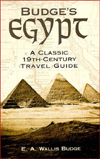










book links
dover
publications
Sir E. A. Wallis Budge
reprint 2001
online booksellers
abebooks.com
alibris.com
amazon.com
barnes and noble
booksense.com
borders
edward r hamilton
half.com
powells books
travel books
history
language
general
Budge's Egypt
 While
not exactly a travel guide, per se, Budge's Egypt is subtitled "A Classic 19th Century Travel Guide".
It was originally published in 1890 as "The Nile:
Notes for Travelers in Egypt" and is meant to
be a gentle introduction to the culture and history
of Egypt for those gentle Englishmen and Englishwomen
venturing out into the wilds of the Sahara desert.
They came to see the wonders of Egypt, which gained
a tremendous amount of attention from the antiquities
coming to England and the rest of Europe.
While
not exactly a travel guide, per se, Budge's Egypt is subtitled "A Classic 19th Century Travel Guide".
It was originally published in 1890 as "The Nile:
Notes for Travelers in Egypt" and is meant to
be a gentle introduction to the culture and history
of Egypt for those gentle Englishmen and Englishwomen
venturing out into the wilds of the Sahara desert.
They came to see the wonders of Egypt, which gained
a tremendous amount of attention from the antiquities
coming to England and the rest of Europe.
The book focuses on the major sites on the nile, and spends quite a bit of time talking about the country of Egypt and its history. I have a penchant for picking up old travel guides -- I love the view of the world that these early travel writers had, and the more relaxed and elegant travel style they seem to have fostered. Nowadays, you can fly to Egypt from New York in about 11 hours, and trains and cars make the long drive along the Nile a quick jaunt.
When travelers were reliant on ships or overland to get to these remote places, the pace of travel was quite a bit more sedate. But what interests me the most is the often patronizing and colonial view that travel writers had about the lands they described. The Egypt described by Budge is one of English opulence and poor, backwards natives who needed the influence of "the world". It's an interesting view. Budge - a renowned scholar of his day-- obviously has tremendous respect for the ancient culture that he is describing, but he does reflect the view that "modern Egypt" is backwards, unsophisticated, and primitive.
But the history doesn't change much, despite being colored by the hindsight of our current culture, and Budge's detailed description of the temples and tombs is interesting. It is especially interesting for the sites that are no longer open, or those that have changed dramatically (Philae, for example.) The esteemed Cook Travel Agency -- the first to organize cruises down the Nile -- provided a copy of this work to each and every guest traveling with them around the turn of the century.
Much of Budge's work in translating hieroglyphs has been dismissed fairly recently as inaccurate, so his translations and historic timelines shouldn't be taken as gospel. Most of his scholarly works can be found it the Dover reprints.